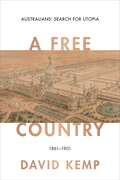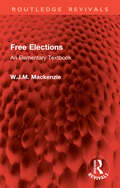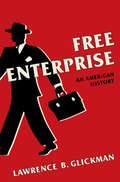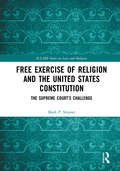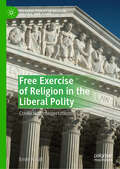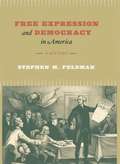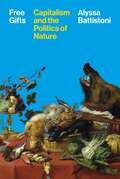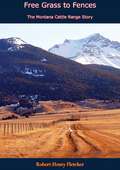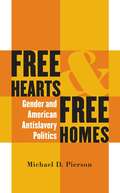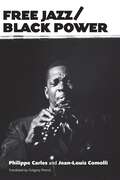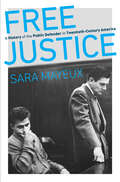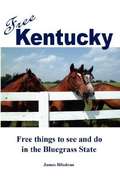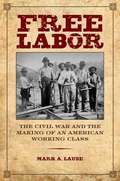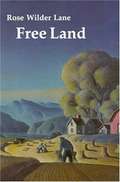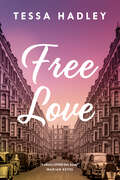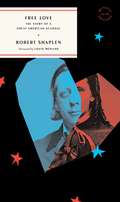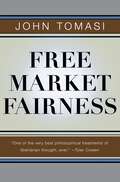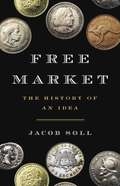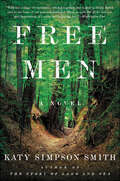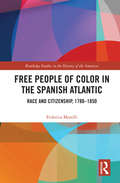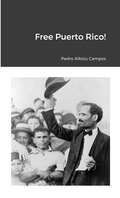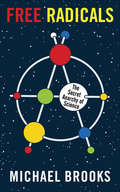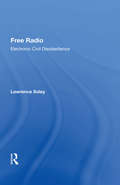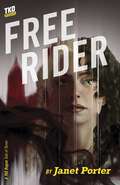- Table View
- List View
Free Country: Australians' Search for Utopia 1861–1901
by David KempA Free Country: Australians' Search for Utopia 1861-1901 tells how Australians, inspired by their new democracy, attempted to use their freedom to build a society without social and economic conflict. As the second book in a landmark five-volume Australian Liberalism series, A Free Country shows the successes and missteps in the attempt to establish the legal and moral foundations for a liberal society in Australia, examining the ideological battles of the period. The national politics of twentieth-century Australia had their roots during this time, as utopian dreams of 'social reconstruction' opposed liberal ideals of individual freedom, fostering the concept of 'class wars' and leading to the ongoing involvement of trade unions in politics. As emerging collective ideas of nationalism, empire, race and class challenged individual rights and threatened to seed domestic and international conflict, liberals succeeded in bringing the six colonies into one Australian nation founded on liberal principles, writing a constitution hailed as the most democratic in the world.
Free Elections: An Elementary Textbook (Routledge Revivals)
by W.J.M. MackenzieOriginally published in 1958 at a time when many African and Asian nations were newly independent or going through the process of independence, this book sets out the facts and arguments which have to be considered in designing and running electoral systems. The book treats the problems of free elections in Africa and Asia objectively and uncontroversially, without pre-supposing any previous training in political science. The discussion of 'free elections' raises large issues about political norms and ideologies and about the working of political systems in different societies, and the book tackles these questions head on. The book gives a balanced account of the whole issue of elections, covering on the one hand qualifications and voting systems, and on the other hand less ‘political’ questions of administration and control, which are of equal importance in the working of an electoral system.
Free Enterprise: A Novel of Mary Ellen Pleasant
by Michelle CliffIn 1858, two black women meet at a restaurant and begin to plot a revolution. Mary Ellen Pleasant owns a string of hotels in San Francisco that secretly double as havens for runaway slaves. Her comrade, Annie, is a young Jamaican who has given up her life of privilege to fight for the abolitionist cause. Together they join John Brown's doomed enterprise and barely escape with their lives. With mesmerizing skill, Cliff weaves a multitude of voices into a gripping, poignant story of the struggle for liberation that began not long after the first slaves landed on America's shores.
Free Enterprise: An American History
by Lawrence B. GlickmanAn incisive look at the intellectual and cultural history of free enterprise and its influence on American politics Throughout the twentieth century, “free enterprise” has been a contested keyword in American politics, and the cornerstone of a conservative philosophy that seeks to limit government involvement into economic matters. Lawrence B. Glickman shows how the idea first gained traction in American discourse and was championed by opponents of the New Deal. Those politicians, believing free enterprise to be a fundamental American value, held it up as an antidote to a liberalism that they maintained would lead toward totalitarian statism. Tracing the use of the concept of free enterprise, Glickman shows how it has both constrained and transformed political dialogue. He presents a fascinating look into the complex history, and marketing, of an idea that forms the linchpin of the contemporary opposition to government regulation, taxation, and programs such as Medicare.
Free Exercise of Religion and the United States Constitution: The Supreme Court’s Challenge (ICLARS Series on Law and Religion)
by Mark P. StrasserThe United States is extremely diverse religiously and, not infrequently, individuals sincerely contend that they are unable to act in accord with law as a matter of conscience. The First Amendment to the United States Constitution protects the free exercise of religion and the United States Supreme Court has issued many decisions exploring the depth and breadth of those protections. This book addresses the Court’s free exercise jurisprudence, discussing what counts as religion and the protections that have been afforded to a variety of religious practices. Regrettably, the Court has not offered a principled and consistent account of which religious practices are protected or even how to decide whether a particular practice is protected, which has resulted in similar cases being treated dissimilarly. Further, the Court’s free exercise jurisprudence has been used to provide guidance in interpreting federal statutory protections, which is making matters even more chaotic. This book attempts to clarify what the Court has said in the hopes that it will contribute to the development of a more consistent and principled jurisprudence that respects the rights of the religious and the non-religious.
Free Exercise of Religion in the Liberal Polity: Conflicting Interpretations (Palgrave Studies in Religion, Politics, and Policy)
by Emily R. GillThis book addresses the challenge of providing for the free exercise of religion without allowing religious exercise by some individuals and groups to impinge upon the conscientious convictions of others. State neutrality toward religion is impossible, because neutrality means inattention to religion for some, but leveling the playing field through accommodations or exemptions for others. Both formal and substantive neutrality have a place in addressing particular conflicts. One such example is public funding for religiously affiliated social service programs, for which neither type of neutrality is satisfactory and thus some restrictions are justifiable; conversely, private voluntary organizations that do not receive direct public funding should be allowed wide latitude regarding their practices. This title also examines the expansive free exercise claims that are now made by those who argue that following the law impinges upon their beliefs, as exemplified by the ministerial exception and the Hobby Lobby and Masterpiece Cakeshop Supreme Court cases. It concludes by analyzing the relationship between neutrality and marriage as a civil status, which impacts a variety of commitment types and plural marriage.
Free Expression and Democracy in America: A History
by Stephen M. FeldmanCharting the course of free expression alongside the nation's political evolution, from the birth of the Constitution to the quagmire of the Vietnam War, Stephen M. Feldman argues that our level of freedom is determined not only by the Supreme Court, but also by cultural, social, and economic forces. Along the way, he pinpoints the struggles of excluded groups -- women, African Americans, and laborers -- to participate in democratic government as pivotal to the development of free expression.
Free Gifts: Capitalism and the Politics of Nature
by Alyssa BattistoniA timely new critique of capitalism&’s persistent failure to value natureCapitalism is typically treated as a force for relentless commodification. Yet it consistently fails to place value on vital aspects of the nonhuman world, whether carbon emissions or entire ecosystems. In Free Gifts, Alyssa Battistoni explores capitalism&’s persistent failure to value nature, arguing that the key question is not the moral issue of why some kinds of nature shouldn&’t be commodified, but the economic puzzle of why they haven&’t been. To understand contemporary ecological problems from biodiversity collapse to climate change, she contends, we have to understand how some things come to have value under capitalism—and how others do not. To help us do so, Battistoni recovers and reinterprets the idea of the free gift of nature used by classical economic thinkers to describe what we gratuitously obtain from the natural world, and builds on Karl Marx&’s critique of political economy to show how capitalism fundamentally treats nature as free for the taking. This novel theory of capitalism&’s relationship to nature not only helps us understand contemporary ecological breakdown, but also casts capitalism&’s own core dynamics in a new light.Battistoni addresses four different instances of the free gift in political economic thought, each in a specific domain: natural agents in industry, pollution in the environment, reproductive labor in the household, and natural capital in the biosphere. In so doing, she offers new readings of major twentieth-century thinkers, including Friedrich Hayek, Simone de Beauvoir, Garrett Hardin, Silvia Federici, and Ronald Coase. Ultimately, she offers a novel account of freedom for our ecologically troubled present, developing a materialist existentialism to argue that capitalism limits our ability to be responsible for our relationships to the natural world, and imagining how we might live freely while valuing nature&’s gifts.
Free Grass to Fences: The Montana Cattle Range Story
by Robert Henry FletcherThe full story of the Montana cattle industry, from the earliest days of the fur traders down to the latest Miles City Roundup, written by a man who knows the northwestern range land and its history without a map.One of the essential works on Montana Range Books by one whose family and personal work was intimately involved with the association. Robert Athearn notes it is a fine book dealing with the entire history of the West from the fur trade to the great ranches after 1885. He further observes that though it shows a conservative complaint against the New Deal and having to deal with Federal and State Bureaucrats, he nevertheless shows that the rancher on his own has genuine environmental concerns that do not coincide with mining and allied interests. The author also was famous for the song: “Don’t Fence Me In” sung by Bing Crosby.
Free Hearts and Free Homes
by Michael D. PiersonBy exploring the intersection of gender and politics in the antebellum North, Michael Pierson examines how antislavery political parties capitalized on the emerging family practices and ideologies that accompanied the market revolution.From the birth of the Liberty party in 1840 through the election of Republican Abraham Lincoln in 1860, antislavery parties celebrated the social practices of modernizing northern families. In an era of social transformations, they attacked their Democratic foes as defenders of an older, less egalitarian patriarchal world. In ways rarely before seen in American politics, Pierson says, antebellum voters could choose between parties that articulated different visions of proper family life and gender roles.By exploring the ways John and Jessie Benton Fremont and Abraham and Mary Todd Lincoln were presented to voters as prospective First Families, and by examining the writings of Harriet Beecher Stowe, Lydia Maria Child, and other antislavery women, Free Hearts and Free Homes rediscovers how crucial gender ideologies were to American politics on the eve of the Civil War.
Free Jazz/Black Power (American Made Music Series)
by Philippe Carles Jean-Louis ComolliIn 1971, French jazz critics Philippe Carles and Jean-Louis Comolli cowrote Free Jazz/Black Power, a treatise on the racial and political implications of jazz and jazz criticism. It remains a testimony to the long-ignored encounter of radical African American music and French left-wing criticism. Carles and Comolli set out to defend a genre vilified by jazz critics on both sides of the Atlantic by exposing the new sound’s ties to African American culture, history, and the political struggle that was raging in the early 1970s. The two offered a political and cultural history of Black presence in the United States to shed more light on the dubious role played by jazz criticism in racial oppression. This analysis of jazz criticism and its production is astutely self-aware. It critiques the critics, building a work of cultural studies in a time and place where the practice was virtually unknown. The authors reached radical conclusions—free jazz was a revolutionary reaction against white domination, was the musical counterpart to the Black Power movement, and was a musical style that demanded a similar political commitment. The impact of this book is difficult to overstate, as it made readers reconsider their response to African American music. In some cases, it changed the way musicians thought about and played jazz. Free Jazz/Black Power remains indispensable to the study of the relation of American free jazz to European audiences, critics, and artists. This monumental critique caught the spirit of its time and realigned that zeitgeist.
Free Justice: A History of the Public Defender in Twentieth-Century America (Justice, Power, and Politics)
by Sara MayeuxEvery day, in courtrooms around the United States, thousands of criminal defendants are represented by public defenders--lawyers provided by the government for those who cannot afford private counsel. Though often taken for granted, the modern American public defender has a surprisingly contentious history--one that offers insights not only about the "carceral state," but also about the contours and compromises of twentieth-century liberalism. First gaining appeal amidst the Progressive Era fervor for court reform, the public defender idea was swiftly quashed by elite corporate lawyers who believed the legal profession should remain independent from the state. Public defenders took hold in some localities but not yet as a nationwide standard. By the 1960s, views had shifted. Gideon v. Wainwright enshrined the right to counsel into law and the legal profession mobilized to expand the ranks of public defenders nationwide. Yet within a few years, lawyers had already diagnosed a "crisis" of underfunded, overworked defenders providing inadequate representation--a crisis that persists today. This book shows how these conditions, often attributed to recent fiscal emergencies, have deep roots, and it chronicles the intertwined histories of constitutional doctrine, big philanthropy, professional in-fighting, and Cold War culture that made public defenders ubiquitous but embattled figures in American courtrooms.
Free Kentucky: Free Things to See and Do in the Bluegrass State
by James V. BilodeauEven in this day and age of super corporations, world trade, stock market gambles, and a general preoccupation for wealth - many things are still free. Tourism today is a multi-billion dollar industry, which is growing at a rapid pace. Mega-amusement parks, roadside attractions, and adventures pop up across the countryside on a daily basis. Most of the increase in the number of attractions is for-profit ventures, but even in the booming for profit tourism industry, there are many opportunities for free entertainment. Free Kentucky will guide you to the best no cost attractions in Kentucky. Not simply a guidebook, Free Kentucky also tells the history about some of the most interesting attractions within the state.
Free Labor: The Civil War and the Making of an American Working Class
by Mark A. LauseMonumental and revelatory, Free Labor explores labor activism throughout the country during a period of incredible diversity and fluidity: the American Civil War. Mark A. Lause describes how the working class radicalized during the war as a response to economic crisis, the political opportunity created by the election of Abraham Lincoln, and the ideology of free labor and abolition. Grappling with a broad array of organizations, tactics, and settings, Lause portrays not only the widely known leaders and theoreticians, but also the unsung workers who struggled on the battlefield and the picket line. His close attention to women and African Americans, meanwhile, dismantles notions of the working class as synonymous with whiteness and maleness. In addition, Lause offers a nuanced consideration of race's role in the politics of national labor organizations, in segregated industries in the border North and South, and in black resistance in the secessionist South, creatively reading self-emancipation as the largest general strike in U.S. history.
Free Land
by Rose Wilder Lane(back of book) In the 1880s, when adventure lay in the conquest of the prairies, David Beaton and his bride came to Dakota to claim three hundred acres of grassland. Rose Wilder Lane tells of their struggle to survive with such force that Free Land has become a classic frontier novel. The young couple experience cyclones, droughts, and blizzards that isolate them for days in their sod shanty and endanger their livestock. The simple pleasures of home cooking, horse trading, and socializing interrupt work, here described in its wealth of variety. In every detail, Free Land comes to life because Lane grew up in the time and place of which she writes. The book embodies her belief that "living is never easy, that all human history is a record of achievement in disaster, and that our great asset is the valor of the American spirit."
Free Love
by Tessa HadleyA compulsive new novel about one woman&’s sexual and intellectual awakening in 1960s London.1967. While London comes alive with the new youth revolution, the suburban Fischer family seems to belong to an older world of conventional stability: pretty, dutiful homemaker Phyllis is married to Roger, a devoted father with a career in the Foreign Office. Their children are Colette, a bookish teenager, and Hugh, the golden boy.But when the twenty-something son of an old friend pays the Fischers a visit one hot summer evening, and kisses Phyllis in the dark garden after dinner, something in her catches fire. Newly awake to the world, Phyllis makes a choice that defies all expectations of her as a wife and a mother. Nothing in these ordinary lives is so ordinary after all, it turns out, as the family&’s upheaval mirrors the dramatic transformation of the society around them.With scalpel-sharp insight, Tessa Hadley explores her characters&’ inner worlds, laying bare their fears and longings. Daring and sensual, Free Love is an enthralling, irresistible exploration of romantic love, sexual freedom and living out the truest and most meaningful version of our lives.
Free Love: The Story of a Great American Scandal (McNally Editions)
by Robert ShaplenA wry, instructive, and hugely entertaining account of &“one of the most sensational trials in American history&” (New York Times Book Review).On the night of July 3, 1870, Elizabeth Tilton confessed to her husband that she&’d had an affair with their pastor, Henry Ward Beecher. This secret would soon transfix America, for Beecher was the most famous preacher of the day, founder of the most fashionable church in Brooklyn Heights, a presidential hopeful, an influential supporter of Abolition, and a leader of the campaign for women&’s suffrage. When Beecher tried to silence the Tiltons, it was a whisper network of suffragists, notably Susan B. Anthony and Elizabeth Cady Stanton, who spread news of the affair, and it was the radical Victoria Woodhull—an outspoken proponent of &“free love&”—who seized on it, as political dynamite, to blow up the myth of monogamy among the political elite. Her public accusations led to even more public trials, which shocked the country and divided the most progressive thinkers of the era. In 1953, the journalist Robert Shaplen revisited the Tilton-Beecher affair in a series of articles for the New Yorker, relying on 3,000 pages of contemporary accounts—court transcripts, love-letters, newspaper reports and illustrations, even political cartoons—to reanimate a scandal that shook the American reform movement and to expose a strand of America&’s cultural DNA that remains recognizable today.
Free Market Fairness
by John TomasiA provocative new vision of free market capitalism that achieves liberal ends by libertarian meansCan libertarians care about social justice? In Free Market Fairness, John Tomasi argues that they can and should. Drawing simultaneously on moral insights from defenders of economic liberty such as F. A. Hayek and advocates of social justice such as John Rawls, Tomasi presents a new theory of liberal justice. This theory, free market fairness, is committed to both limited government and the material betterment of the poor. Unlike traditional libertarians, Tomasi argues that property rights are best defended not in terms of self-ownership or economic efficiency but as requirements of democratic legitimacy. At the same time, he encourages egalitarians concerned about social justice to listen more sympathetically to the claims ordinary citizens make about the importance of private economic liberty in their daily lives. In place of the familiar social democratic interpretations of social justice, Tomasi offers a "market democratic" conception of social justice: free market fairness. Tomasi argues that free market fairness, with its twin commitment to economic liberty and a fair distribution of goods and opportunities, is a morally superior account of liberal justice. Free market fairness is also a distinctively American ideal. It extends the notion, prominent in America's founding period, that protection of property and promotion of real opportunity are indivisible goals. Indeed, according to Tomasi, free market fairness is social justice, American style.Provocative and vigorously argued, Free Market Fairness offers a bold new way of thinking about politics, economics, and justice—one that will challenge readers on both the left and right.
Free Market: The History of an Idea
by Jacob SollFrom a MacArthur &“Genius,&” an intellectual history of the free market, from ancient Rome to the twenty-first centuryAfter two government bailouts of the US economy in less than twenty years, free market ideology is due for serious reappraisal. In Free Market, Jacob Soll details how we got to this current crisis, and how we can find our way out by looking to earlier iterations of free market thought. Contrary to popular narratives, early market theorists believed that states had an important role in building and maintaining free markets. But in the eighteenth century, thinkers insisted on free markets without state intervention, leading to a tradition of ideological brittleness. That tradition only calcified in the centuries that followed.Tracing the intellectual evolution of the free market from Cicero to Milton Friedman, Soll argues that we need to go back to the origins of free market ideology in order to truly understand it—and to develop new economic concepts to face today&’s challenges.
Free Men: A Novel
by Katy Simpson SmithFrom the author of the highly acclaimed The Story of Land and Sea comes a captivating novel, set in the late eighteenth-century American South, that follows a singular group of companions—an escaped slave, a white orphan, and a Creek Indian—who are being tracked down for murder.In 1788, three men converge in the southern woods of what is now Alabama. Cat, an emotionally scarred white man from South Carolina, is on the run after abandoning his home. Bob is a talkative black man fleeing slavery on a Pensacola sugar plantation, Istillicha, edged out of his Creek town’s leadership, is bound by honor to seek retribution.In the few days they spend together, the makeshift trio commits a shocking murder that soon has the forces of the law bearing down upon them. Sent to pick up their trail, a probing French tracker named Le Clerc must decide which has a greater claim: swift justice, or his own curiosity about how three such disparate, desperate men could act in unison.Katy Simpson Smith skillfully brings into focus men whose lives are both catastrophic and full of hope—and illuminates the lives of the women they left behind. Far from being anomalies, Cat, Bob, and Istillicha are the beating heart of the new America that Le Clerc struggles to comprehend. In these territories caught between European, American, and Native nations, a wilderness exists where four men grapple with the importance of family, the stain of guilt, and the competing forces of power, love, race, and freedom—questions that continue to haunt us today.
Free People of Color in the Spanish Atlantic: Race and Citizenship, 1780–1850
by Federica MorelliThis book grapples with the important contemporary question of the boundaries of citizenship and access to naturalization by analyzing a body of relevant juridical sources, dating from the end of the eighteenth century to the first half of the nineteenth century, concerning the free people of color in late colonial and early independent Spanish America. Their precarious status makes this group a privileged subject to examine the negotiation and formation of racial identity as well as the definition of citizenship requirements in colonial and post-colonial contexts. Based on archival material collected in Spain (Seville and Madrid) and Latin America (Mexico City, Bogotá, Quito, Lima and Buenos Aires), the book demonstrates that the access of free people of color to citizenship both in the late colonial and early independent period was not established by state authorities, but resulted from complex dynamics between the state and the local society.
Free Puerto Rico
by Pedro Albizu CamposPedro Albizu Campos (September 12, 1891 – April 21, 1965) was a Puerto Rican attorney and politician, and the leading figure in the Puerto Rican independence movement. Contained in this volume are the most prescient of his words on Puerto Rico, which to this day remains a subject of the United States of America.
Free Radicals: The Secret Anarchy of Science
by Michael Brooks&“An exuberant tour through the world of scientists behaving badly&” (The New York Times). They may have a public image as cool, logical, levelheaded types. But in reality, scientists will do pretty much anything—take drugs, follow mystical visions, lie, and even cheat—to make a discovery. In Free Radicals, physicist and journalist Michael Brooks seamlessly weaves together true stories of the &“mad, bad and dangerous&” men and women who have revolutionized the scientific world, and offers a fast-paced and thrilling exploration of the real process behind discovery (The Times, London). Brooks also traces the cover-up back to its source: the scientific establishment&’s reaction to the public fear of science after World War II. He argues that it its high time for science to come clean about just how bold and daring scientists really are. &“Not all scientists are nerds. In Free Radicals, physicist Michael Brooks tries to dispel the notion that scientists are stuffy, pen-protector-polishing bookworms.&” —The Washington Post &“Insightful . . . A page-turning, unvarnished look at the all-too-human side of science.&” —Kirkus Reviews
Free Radio: Electronic Civil Disobedience (Critical Studies In Communication And In The Cultural Industries)
by Lawrence SoleyThis book reviews the history of the microradio movement, enabling readers to understand why and how it has captured momentum and power. It discusses the anti-Nazi underground stations and other resistance stations, explaining how previous stations provided vehicles for democratic communications.
Free Rider (TKO Rogue)
by Janet PorterSet in 1970s New York City, this dark coming-of-age thriller follows twin sisters as corruption, decadence, and greed engulf any vestiges of innocence, trust, and security they may have left. Khalika and Violet, twin girls growing up in a privileged hell, are on the cusp of adulthood after barely surviving a childhood that threatened to shred their psyches before devouring them both in a seismic swirl of pure evil. But one of the sisters has a few moves of her own planned, ones that will require the full cooperation of the other . . .
